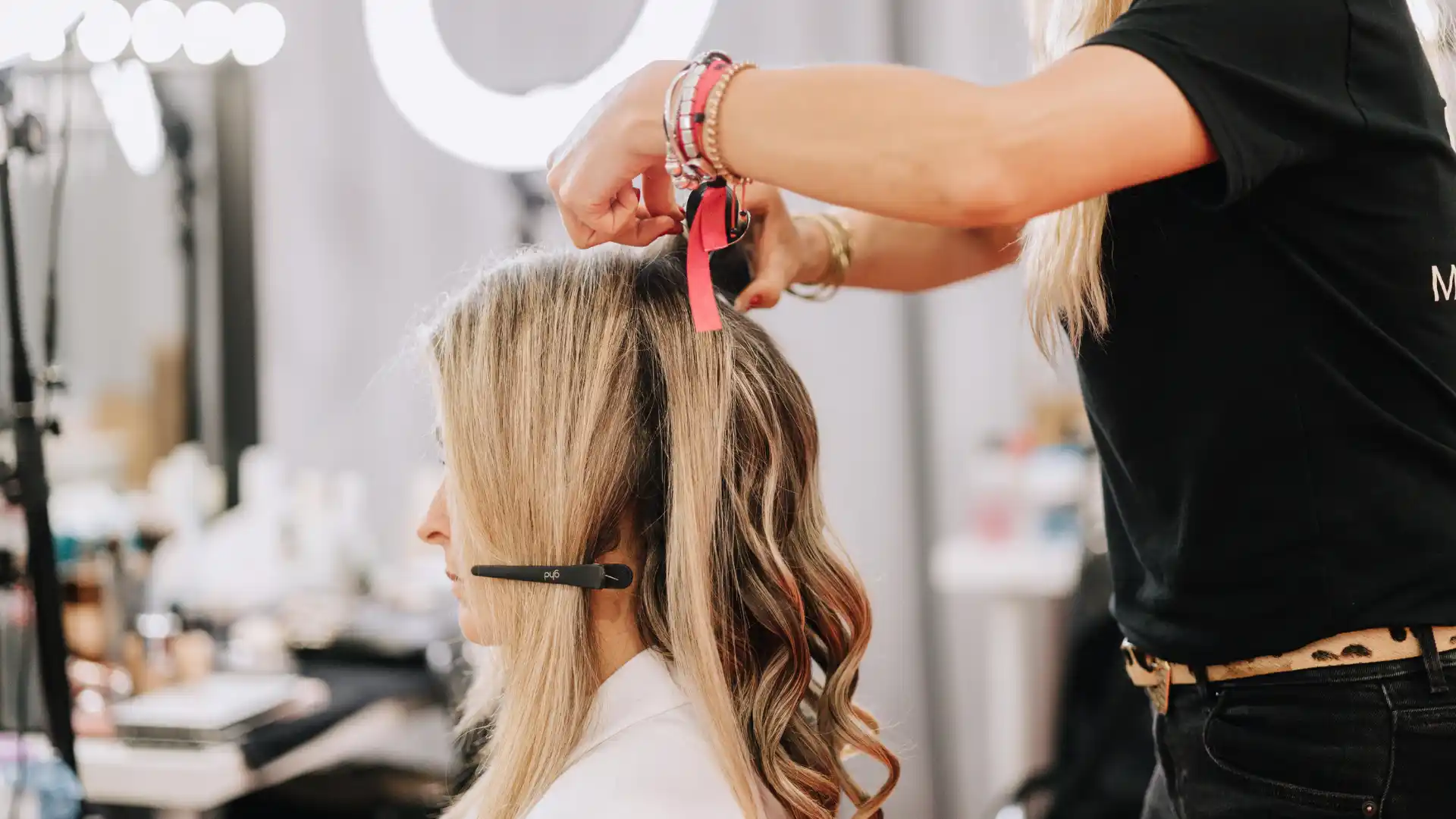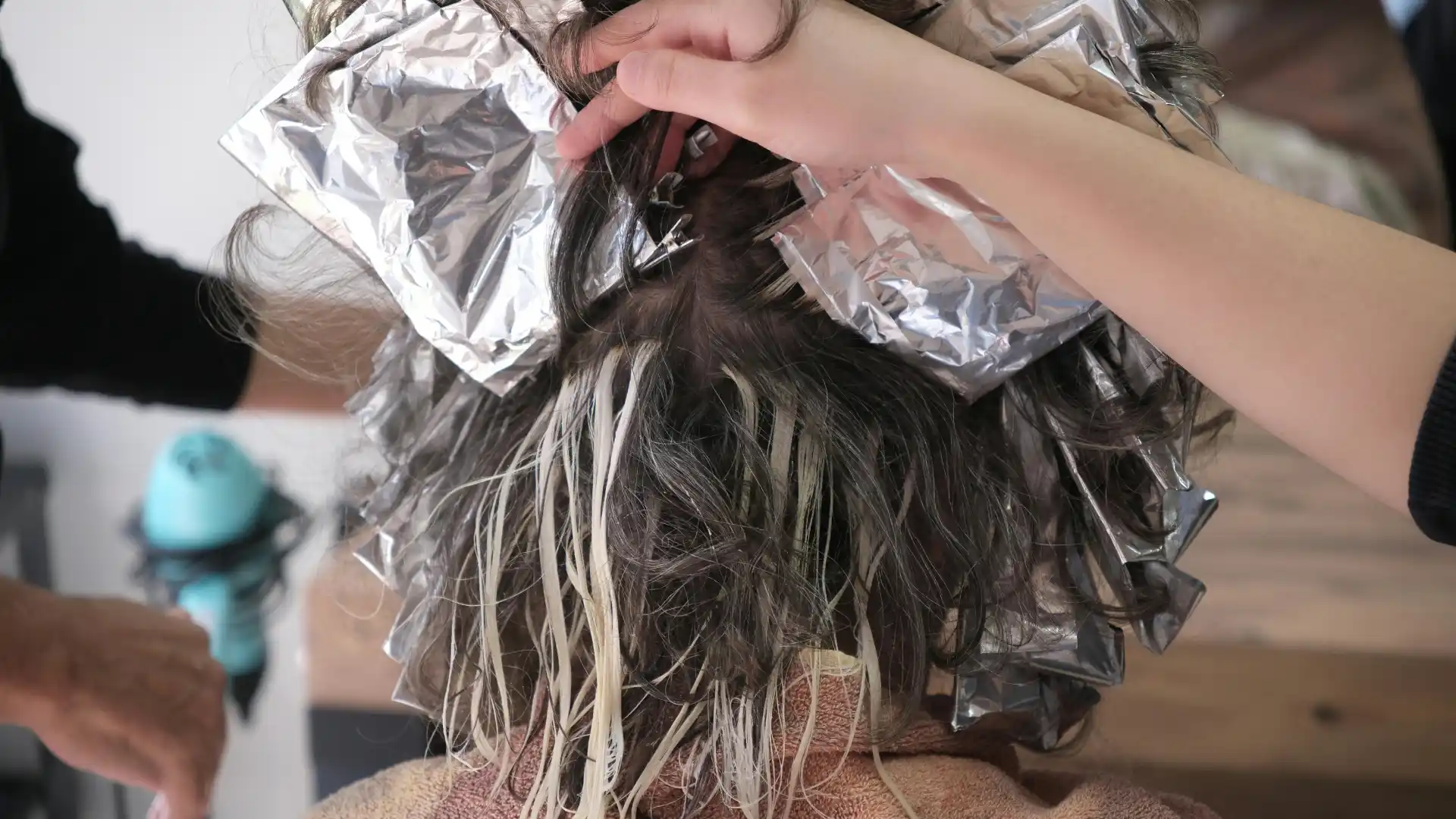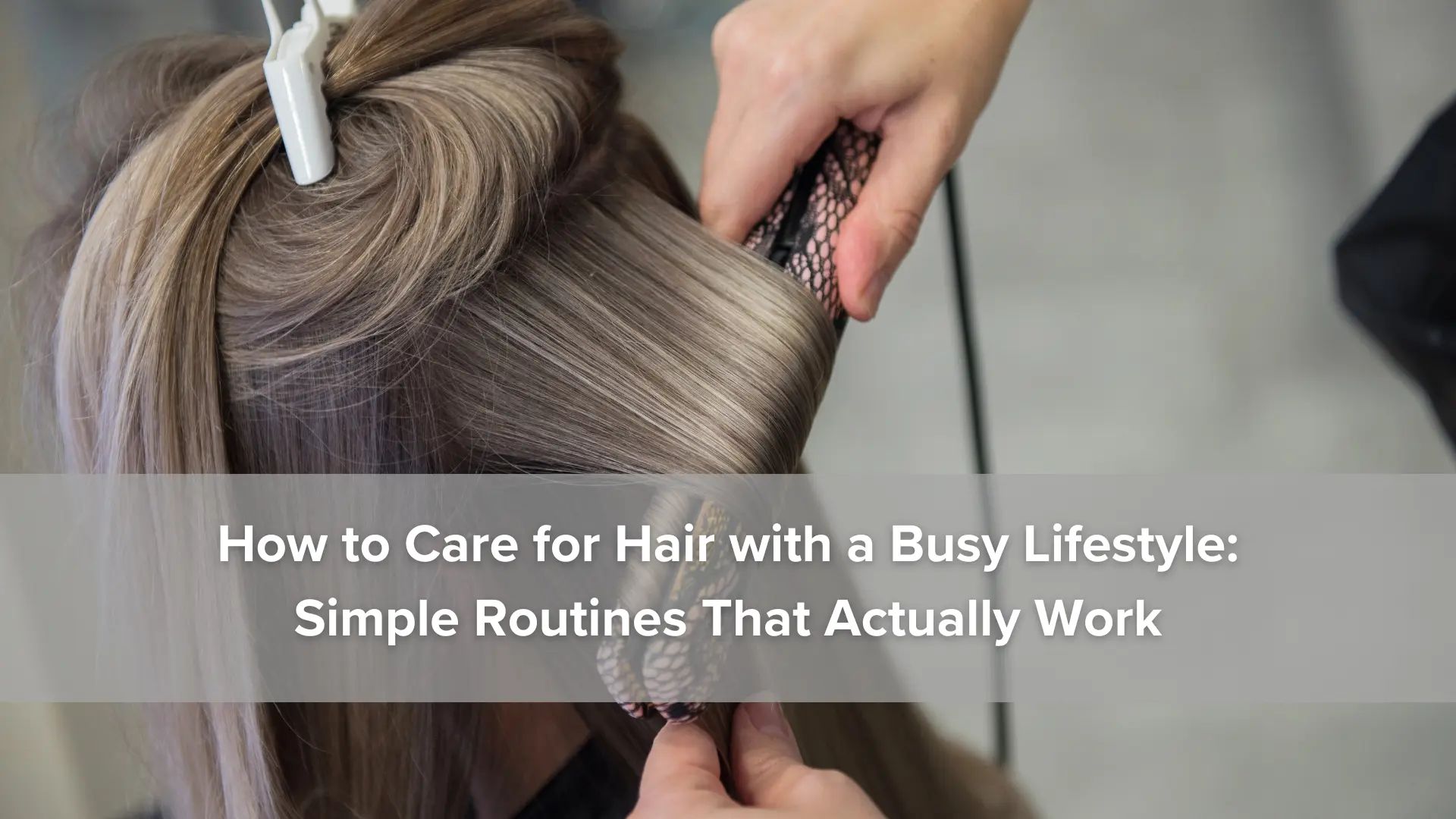Why Understanding Gloss and Toner Matters
Many clients use the terms hair gloss vs toner interchangeably, but they serve different purposes. While both enhance hair appearance, they work in distinct ways, and choosing the right treatment can make all the difference in achieving your desired look.
At Therapy Hair Studio, our master colorists help clients understand these treatments, enabling them to make informed decisions about their hair care. Whether you’re looking to add shine, neutralize brassy tones, or refresh your color between appointments, we’re here to guide you. Learn more about our hair color services to explore all the options available, or visit our main salon page to discover our full range of beauty services.
Let’s break down what each treatment does, how they differ, and which one might be right for your unique hair needs.
What Is Hair Gloss?
Hair gloss is a semi-permanent cosmetic treatment designed to add shine, vibrancy, and smoothness to your hair. Unlike permanent color, gloss contains no ammonia or harsh lightening agents, making it a gentler option for all hair types. According to the Professional Beauty Association, semi-permanent color treatments like gloss are formulated to be gentler on hair while still delivering visible results.
How Hair Gloss Works
The key characteristic of gloss is that it enhances your existing hair color without significantly changing it. Whether you choose a clear gloss or a tinted one, the primary benefit is adding luminous shine and reflectiveness while conditioning your hair. This is particularly beneficial for clients with color-treated hair who want to maintain their investment in their hair color.
Longevity: Hair gloss typically lasts 4 to 6 weeks with proper maintenance, gradually fading with each wash.
Best for: All hair types and colors, including natural, color-treated, highlighted, or previously lightened hair.
Benefits of Hair Gloss
- Adds luminous shine and reflectiveness – Your hair will look healthier and more vibrant
- Smooths hair cuticle and reduces frizz – Creates a polished, sleek appearance
- Revitalizes dull, tired-looking hair – Perfect for refreshing color between major services
- Low-commitment color option – No permanent changes; fades gradually
- Nourishes and conditions hair – Contains conditioning agents that improve hair health
- Perfect for special events or regular maintenance – Ideal before weddings, photoshoots, or date nights
At Therapy Hair Studio, we use high-quality, naturally derived products that not only add shine but also strengthen and soften your hair. Our approach to hair care emphasizes the importance of using quality products, which is why we recommend proper hair care maintenance between salon visits. For those interested in understanding more about hair texture and care, we offer comprehensive guidance.
What Is Hair Toner?
How Hair Toner Works
Hair toner is a semi-permanent color treatment that corrects and neutralizes unwanted tones in lightened or bleached hair. Unlike gloss, toner contains color pigments and uses a developer, which slightly swells the hair cuticle, allowing the pigment to deposit. The American Academy of Dermatology recognizes that color-treated hair requires specialized care to maintain its health and vibrancy.
The primary benefit of toner is neutralizing brassy, yellow, or orange tones that often appear after bleaching or lightening. If you’ve ever noticed your blonde hair turning brassy or your highlights looking too warm, toner is the solution. Many clients also explore balayage techniques, which often benefit from toning, or consider ombre and balayage services for added dimensionality in their color.
Longevity: Hair toner typically lasts 2 to 4 weeks, depending on the porosity of your hair and the frequency of washing.
Best for: Blonde, highlighted, or previously lightened hair that needs color correction or tone adjustment.
Benefits of Hair Toner
Hair toner offers multiple benefits for maintaining beautiful, healthy-looking color. It neutralizes unwanted warm tones, removing brassy, yellow, or orange hues for a cleaner, more polished finish. Toner also enhances color vibrancy, boosts shine, and helps your hair look fresher between salon visits. By balancing the tone of blonde, highlighted, or color-treated hair, it preserves your desired shade and extends the life of your color.
Key Differences: Gloss vs. Toner at a Glance
| Aspect | Hair Gloss |
Hair Toner
|
|---|---|---|
| Primary Purpose | Shine enhancement and vibrancy | Color correction and tone neutralization |
| Best Hair Type | All hair types (natural, colored, highlighted) | Blonde, highlighted, or lightened hair |
| Color Change | Minimal color shift; enhances existing color | Noticeable tone adjustment |
| Longevity | 4 to 6 weeks | 2 to 4 weeks |
| Application | Universal; works on any hair | Specific to lightened hair |
| End Result | Reflective, smooth, shiny finish | Neutralized, balanced tone |
| Contains | No ammonia; conditioning agents | Color pigments; developer |
When to Choose Gloss vs. Toner for Your Hair
Choose Hair Gloss if:
- You want to enhance shine without changing color
- Your hair is dull or lacks vibrancy
- You have natural or color-treated hair in any shade
- You’re preparing for a special event and want extra polish
- You want a low-commitment color refresh between major services
- You need conditioning and frizz control
- You want to maintain your current color while improving your appearance
Choose Hair Toner if:
- You have blonde, highlighted, or lightened hair
- Your hair has unwanted brassy or yellow tones
- You want to neutralize warmth and achieve a cooler shade
- You’re correcting a previous color treatment
- You want to extend the life of your color service
- You’re looking for subtle color adjustment with conditioning benefits
- You want to blend gray hair with your base color
Pro Tip: Many clients benefit from both treatments. Our stylists often recommend applying a gloss after toning to enhance shine and seal in the color for longer-lasting results. This combination approach is similar to how we approach hair extensions – layering services for optimal results.
The Therapy Hair Studio Difference: Expert Color Consultation
At Therapy Hair Studio, we don’t believe in one-size-fits-all color treatments. Every client’s hair is unique, and so is our approach to styling it. Visit our about us page to learn more about our salon’s philosophy and history, or explore our featured editorial work to see our expertise in action.
Our master colorists, including Bryan Nguyen, Elia Graves, Kelsey Champion, Erin Conley, and Karla Godinez, assess each client’s hair individually during a personalized consultation. We consider:
- Your hair type and texture
- Current hair condition and porosity
- Your lifestyle and maintenance preferences
- Your color goals and desired outcome
- Any previous color treatments or damage
We use high-quality, naturally derived products that nourish your hair while delivering professional results. As Houston’s premier salon since 2008, we’ve perfected the art of custom color. Discover our hair extension services and other specialized treatments, including Brazilian Blowout services.
Maintenance Tips: Keeping Your Gloss or Toner Looking Fresh
Once you’ve invested in a beautiful gloss or toner treatment, you’ll want to keep it looking vibrant. Here’s how:
At-Home Care:
- Use sulfate-free, color-safe shampoo and conditioner – Sulfates strip color and natural oils. Learn more about how often you should wash your hair for your specific hair type.
- Wash in cool water – Seals the hair cuticle and helps color last longer
- Limit heat styling – Or use heat protectant products before blow-drying or straightening. Check out our guide on how to blow-dry hair for salon-worthy results at home.
- Deep condition weekly – Keeps hair nourished and color-treated hair healthy
- Avoid chlorine and saltwater – Both can fade color and cause unwanted tones. Learn about how to protect hair from sun damage.
For more detailed guidance on maintaining your hair between appointments, check out our guide on how to keep hair color from fading.
Professional Maintenance:
- Schedule touch-ups every 3 to 4 weeks for gloss – Maintains shine and vibrancy
- Schedule touch-ups every 2 to 4 weeks for toner – Keeps neutralized tones fresh
- Consider purple or blue-toning shampoo – Use 1 to 2 times weekly at home for blonde hair between salon visits. Learn more about how often you should use purple shampoo as a blonde.
- Book a scalp treatment – Our naturally derived scalp treatments keep your hair healthy and strong
Ready to Transform Your Hair? Book Your Appointment at Therapy Hair Studio
Whether you’re looking to add shine with a gloss, neutralize brassy tones with a toner, or explore both options, Therapy Hair Studio is Houston’s premier destination for custom color and luxury beauty services.
Since 2008, our expert colorists have been helping clients achieve their hair goals with precision, artistry, and personalized care. We’re not just a salon, we’re your partner in bringing out your unique inner beauty. Explore our bridal hair and makeup services for special occasions, or browse our testimonials to see what our clients have to say about their experiences.
Get Started Today
Location: 2727 Saint St., Houston, TX 77027 (Galleria Area)
Phone: (713) 355-4247
Hours: Tuesday through Saturday, 9:00 AM to 6:00 PM (closed Sunday through Monday)
Online booking: Our Contact Page
First-time clients: Mention this blog when you call to schedule your personalized color consultation. Our stylists are ready to help you select the ideal treatment for your hair.
Frequently Asked Questions
Can I use gloss and toner together?
Yes! Many salons, including Therapy Hair Studio, apply a gloss after toning to enhance shine and seal in color. This combination can extend the life of your toner and give you the best of both treatments. Our stylists can recommend the perfect combination for your hair. This approach is similar to how we combine highlights and lowlights for dimensional color.
How much does hair gloss or toner cost?
Pricing varies based on hair length, thickness, and complexity. At Therapy Hair Studio, we offer personalized consultations to discuss pricing and options. Call (713) 355-4247 to book your appointment and get a quote. Visit our pricing page for more information.
Can I apply toner at home?
Professional application is recommended for best results, especially for full toners. However, purple or blue-toning shampoos can be used 1 to 2 times weekly for maintenance between salon visits. These are gentler and help extend the life of your professional toner. Learn more about how often you should use purple shampoo as a blonde.
How long does a gloss or toner appointment take?
Typically, 30 to 60 minutes, depending on your hair length and the specific treatment. During your consultation, we’ll give you a more accurate time estimate. For context, our haircut services typically take a similar timeframe.
Will gloss or toner damage my hair?
Both gloss and toner are semi-permanent and gentler than permanent color. Our high-quality products include conditioning agents to nourish your hair. However, if your hair is already damaged or over-processed, we recommend a consultation to assess your hair’s health first. For more information, read our article: Will Highlights Damage My Hair?.
How often should I get a gloss or toner?
For best results, schedule touch-ups every 3 to 4 weeks for gloss and every 2 to 4 weeks for toner. Many clients combine these with their regular haircut appointments for convenience. Some also pair these services with makeup services for special occasions.










